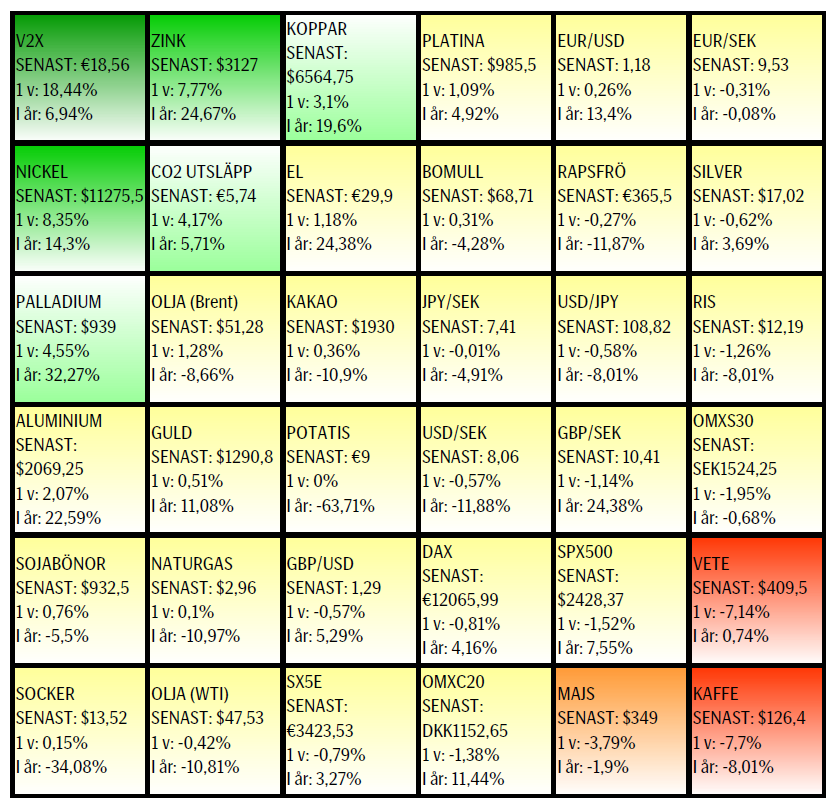Analys
SEB Råvarubrev 22 augusti 2017

 Rallyt i industrimetaller går för fort!
Rallyt i industrimetaller går för fort!
MARKNADEN I KORTHET
Sommaren har bjudit på en viss dramatik avseende en betydligt svagare dollar än vad undertecknad hade förväntat sig. Dessutom har börserna uppvisat en del svaghetstecken. Nordkorea har varit i fokus och kommer nog att var så ytterligare ett tag. För innevarande vecka så väntar nog marknaden på framför allt på den kommande Jackson Hole konferensen (24 – 26 aug) där både Mrs. Yellen och Signori Draghi kommer att tala. Marknaden kommer att lusläsa talen i sökandet efter indikationer om den framtida penningpolitiken. Man kan väl misstänka att Hr. Draghi kommer att vara återhållsam för att inte ytterligare ”prata” upp euron (tysk BNP var ju senast något svagare med utrikeshandeln svag (starkare €?) men med draghjälp från den inhemska ekonomin) inför ECB mötet den 7 september.
Råvaror: Oljepriset ser i och med återvändandet över $50/fat att verkligen ha passerat sin lågpunkt. Lagren fortsätter att falla och efterfrågeprognoserna skrivits upp. Adderandet av amerikanska borriggar har mer eller mindre upphört, 0.2 stycke i snitt de senaste sex veckorna. Å andra sidan fortsätter framför allt Irak och Bolivia att pumpa betydligt mer än vad de ska göra enligt överenskommelsen. Industrimetaller har gått starkt under sommaren med järnmalm i täten (~45 %) men börjar i vissa fall lämna fundamentalt motiverade nivåer bakom sig. Zink har nått ett långsiktigt tekniskt mål om $3146, och har i alla fall slutat stiga därefter. Återöppnande av gruvor har nu annonserats vilket väl får anses visa att priset nu är väldigt attraktivt för producenterna. Ädelmetallerna har också stigit med palladium i täten (16 års högsta) med förväntningar att konsumenterna ska gå från diesel till bensinbilar efter dieselskandalerna och den ökade europeiska fokuseringen på utsläpp av kväveoxider (vilket länge varit fokus i USA). Svag dollar och geopolitisk oro har hjälpt upp guldet till $1300 nivån där vi dock tidigare i år vänt ett par gånger. Majs, vete och soja har fallit och föll ännu mer efter den senaste WASDE rapporten. Socker ser ut att ha avslutat sin uppåt korrektion och nya bottnar ser troliga ut. Elpriser har stigit på baksidan av att framför allt kolet stigit samt rykten om likartade problem med fransk kärnkraft som förra hösten då ju priset steg kraftigt.
Valuta: Dollarindex har under sommaren som lägst fallit ned till 92,55, inte långt ifrån huvudstödet vid 91,92 (i USD/SEK termer motsvarar det 8,0575 respektive 7,8935). Lägre förväntningar på framtida FED-höjningar och en tro på att ECB snart ska börja minska sina stimulanser ligger bakom rörelsen (i USD/SEK kan vi addera högre än förväntad inflation i Sverige). Tekniskt sett börjar NOK/SEK se intressant ut för ett möjligt utbrott på uppsidan.
Börser: Europa har som väntat varit den svagaste länken i börskedjan. De negativa signaler som genererades i och med skiftet juni/juli har fortsatt att pressa marknaden och vi ser fortsatt en viss risk för ytterligare nedgång, troligen efter en rekyl. S & P 500 har nått ett första möjligt korrektionsmål vid 2416, så får vi se om stödet håller eller ej.
Räntor: Långa räntor har stigit men nyligen korrigerat lägre. Vi tror att de snart åter ska stiga.
OBSERVATIONER I SAMMANDRAG
- Olja – överlag en något positivare ton.
- Aluminium – för mycket för fort?
- Guld – falskt brott av $1296 ger huvudbry.
- DAX – korrektion inte björnmarknad.
- NOK/SEK – kan norsk BNP komma att lyfta valutaparet?
- OMX30 – svagt men nog dags för en rekyl i nedgången.
En placering i certifikat och warranter är förknippat med risker. Du kan förlora hela ditt investerade kapital. Läs mer om riskerna i SEB:s offentliggjorda Grundprospekt för certifikat- och warrantprogram på seb.se/cert eller seb.se/mini
OLJA BRENT
 Även om vi var lite tidigt ute med att tro på att oljeprisnedgången gjort sitt tog det inte mer än en vecka innan vår vy hamnade i fas med verkligheten. Brottet tillbaka upp över $50 (och 55d mv-bandet) har adderat till en positivare vy. Dessutom såg vi förra veckan antalet borriggar i USA falla, marginellt men ändå en signal om att priset under juli varit väl lågt. Enligt en artikel i WSJ så börjar en del investerare att åter vända blicken mot konventionella oljekällor.
Även om vi var lite tidigt ute med att tro på att oljeprisnedgången gjort sitt tog det inte mer än en vecka innan vår vy hamnade i fas med verkligheten. Brottet tillbaka upp över $50 (och 55d mv-bandet) har adderat till en positivare vy. Dessutom såg vi förra veckan antalet borriggar i USA falla, marginellt men ändå en signal om att priset under juli varit väl lågt. Enligt en artikel i WSJ så börjar en del investerare att åter vända blicken mot konventionella oljekällor.
Konklusion: Återhämtningen ser ut att fortsätta.
OBSERVATIONER
+ Antalet borriggar i USA föll med 5 förra veckan.
+ Neddragningar av amerikanska lager har fortsatt men den ökade produktionen är ett hot.
+ Nedgången i mogna oljefält största sedan 1992.
+ Både IEA och OPEC har nu uppgraderat prognoserna för efterfrågan på olja.
+ Spekulanterna har kraftigt ökat sin långa nettoposition och är nu ungefär lika positiva som i mars.
+ En förlängd OPEC neddragning med 9 månader till 31/3-18.
+ Situationen i Venezuela är fortsatt mycket skakig.
+ Tekniskt sett en försiktig positiv vy så länge junis botten håller.
– OPEC/ icke OPEC uppfyllde bara ~75 % av utlovade neddragningar i juli vilket gör att man överproducerar CA. 470 kfpd.
– STEO kommer troligen att revidera upp US prod. 2018/19.
– Libysk produktion nu uppe i över 1m fpd.
– Forcadoterminalen ökar Nigerias export med ~200k fpd och prognosen för Nigeria är att nå 2m fpd i augusti.
– Hur OPEC’s exitstrategi ska se ut.
– Förslag att sälja halva den amerikanska strategiska reserven, som redan nu krympt en hel del visar statistiken.
– Tekniskt så är det negativt att vi befinner oss under den fallande topplinjen och att vi regelbundet har vänt ned därifrån.
Tillgängliga certifikat:
BULL OLJA X1, X2, X4, X5, & X10 S
BEAR OLJA X1, X2, X4, X5 & X10 S
ALUMINIUM
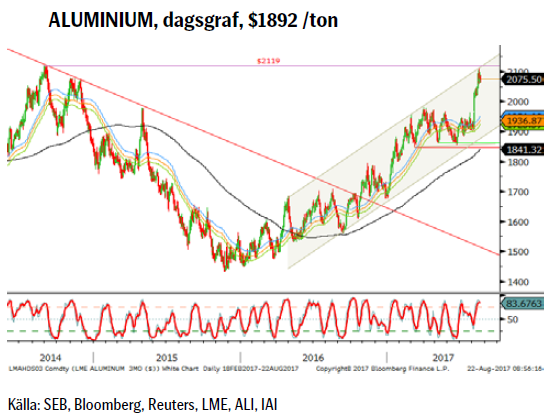 Trots att priset nått nivåer som inte riktigt kan försvaras ur en fundamental synvinkel så fortsätter marknaden att handla starkt. Fokus ligger fortsatt på kinesiska neddragningar och nu senast på nyheter att man i provinsen Shangdong beordrat nedstängning av kapacitet motsvarande drygt 3miljoner ton, något mer än marknadens förväntningar. Här finns en detalj som möjligen kan göra marknaden besviken framöver, det här är i huvudsak beordrad stängning av ”illegal” kapacitet varför den inte kommer att synas i den officiella statistiken.
Trots att priset nått nivåer som inte riktigt kan försvaras ur en fundamental synvinkel så fortsätter marknaden att handla starkt. Fokus ligger fortsatt på kinesiska neddragningar och nu senast på nyheter att man i provinsen Shangdong beordrat nedstängning av kapacitet motsvarande drygt 3miljoner ton, något mer än marknadens förväntningar. Här finns en detalj som möjligen kan göra marknaden besviken framöver, det här är i huvudsak beordrad stängning av ”illegal” kapacitet varför den inte kommer att synas i den officiella statistiken.
Konklusion: Dags för rallyt att ta en paus?
OBSERVATIONER
+ Kinesisk produktion var i juli lägre än i juni.
+ Stigande energipriser (kol) lyfter produktionskostnaderna.
+ Ytterligare produktion riskerar att tvingas att slå igen pga. otillåten verksamhet.
+ Fundamentala faktorer och inte positionering har drivit priset.
+ Den svagare dollarn.
+ Bilindustrin kommer att fortsatt att öka inslaget av alu.
+ LME lagren är relativt låga och i fallande.
+ Fortsatt stark men avsvalnande bostadsmarknad i Kina.
+ Tekniskt befinner sig aluminiumet i en positiv trend.
– Kinesisk industriproduktion blev lägre än förväntat i juli (så även konsumentförsäljning och investeringar).
– Höga lager i Kina (inför risken av framtvingade nedstängningar under perioden nov – mars).
– Oklarheten om vad resultatet blir av att USA dragit Kina inför WTO avseende kinesisk alu-export till USA (subventioner av elpriser).
– Likviditetssituationen i Kina, SHIBOR har efter en mindre rekyl åter börjat stiga.
– Kinesiska myndigheters ”kamp” mot skuggbanksektorn.
– Blir det några infrastruktursatsningar i USA.
– Tekniskt sett bör $2119 nu åtminstone vara ett temporärt tak.
– Tekniskt sett så visar veckografen på en möjlig negativ divergens (dvs.nya toppar i pris, lägre i indikator).
Tillgängliga certifikat:
BULL ALUMINIUM X1, X2 & X4 S
BEAR ALUMINIUM X1, X2 & X4 S
GULD
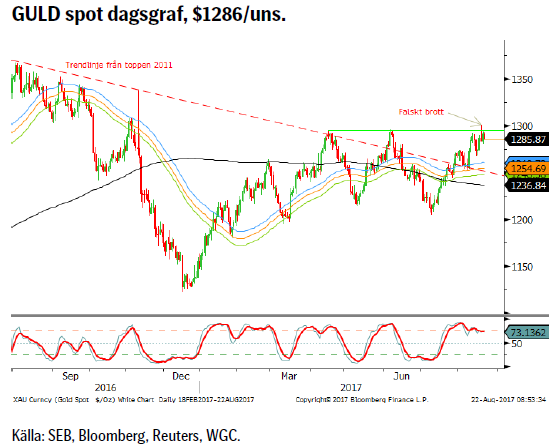 Sedan vår förra uppdatering den 11:e juli så har guldpriset stigit relativt kraftigt. Orsakerna är framför allt, den fallande dollarn (på baksidan av bakslag efter bakslag för Trump samt förväntningar på att ECB börjar minska QE), det amerikanska skuldtaket ($20 triljoner) och Nordkorea. Man kan nu eventuellt argumentera att marknaden nu till viss del prisat in dessa risker och att ytterligare press uppåt behöver ny information. ECB lär vara väldigt försiktiga med att ”prata” upp euron ytterligare, skuldtaket (egentligen nådde vi det i våras men diverse kreativ bokföring gör att man fortfarande håller sig flytande) är inte den katastrof media torgför, USA går inte i konkurs, skatter flyter in och förfallna lån kan återupptas dock inte nya för att täcka budgetunderskottet. Nordkorea är dock svårare att sia om.
Sedan vår förra uppdatering den 11:e juli så har guldpriset stigit relativt kraftigt. Orsakerna är framför allt, den fallande dollarn (på baksidan av bakslag efter bakslag för Trump samt förväntningar på att ECB börjar minska QE), det amerikanska skuldtaket ($20 triljoner) och Nordkorea. Man kan nu eventuellt argumentera att marknaden nu till viss del prisat in dessa risker och att ytterligare press uppåt behöver ny information. ECB lär vara väldigt försiktiga med att ”prata” upp euron ytterligare, skuldtaket (egentligen nådde vi det i våras men diverse kreativ bokföring gör att man fortfarande håller sig flytande) är inte den katastrof media torgför, USA går inte i konkurs, skatter flyter in och förfallna lån kan återupptas dock inte nya för att täcka budgetunderskottet. Nordkorea är dock svårare att sia om.
Konklusion: Det falska brottet över $1296 bör oroa den som kortsiktigt är lång guld.
OBSERVATIONER
+ Dollarns försvagning.
+ Trump misslyckas med att få igenom sina frågor.
+ Förväntan på ECB om minskad QE.
+ Nordkorea problematiken.
+ Den spekulativa nettopositioneringen har ökat kraftigt (minskat antal korta och ökat antal långa kontrakt).
+ Asiatisk fysisk import fortsatt stark.
+ SPDR guld ETF godkända enligt den nya Shariastandarden.
+ Fallande produktion (peak-gold 2015), det är numera guldskrotet som täcker underskottet.
+ Fallande realräntor.
+ Tekniskt så är det positivt att vi åter är över 55d mv bandet och 233d mv samt trendlinjen från toppen 2011.
– Många centralbanker har på senare tid börjat låta betydligt mer hök-aktiga.
– Inflationen är fortsatt låg (utom Sverige, men det är temporärt drivet av semesterresor och elektronikskatt).
– Om dollarn skulle stiga kraftigt.
– Tekniskt väldigt mycket stöd $1260 – 1237 området.
Tillgängliga certifikat:
BULL GULD X1, X2, X4, X5 & X10 S
BEAR GULD X1, X2, X4, X5 & X10 S
DAX
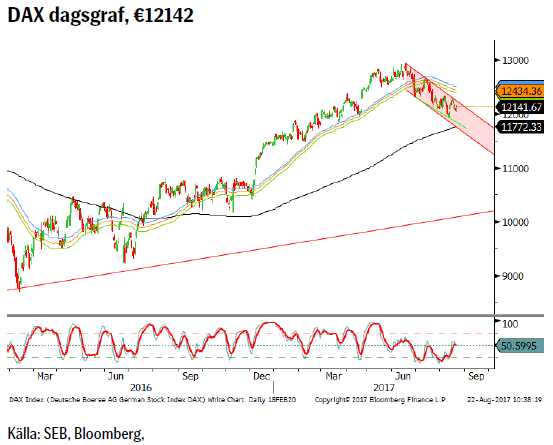 Den tekniska månadssäljsignalen i juni förstärktes i och med prisutvecklingen i juli. Sannolikt måste vi räkna med mer svaghet innan vi hittar fast mark under fötterna. En långsiktig vågräkning är dock fortsatt positiv varför vi fortsätter att etikettera nedgången som korrektiv. Givet den kraftiga förstärkningen av euron bör ECB vara ytterst försiktiga med uttalanden/åtgärder som skulle kunna stödja euron ytterligare. En återgång över 55d mv-bandet krävs för att vända till positiv igen.
Den tekniska månadssäljsignalen i juni förstärktes i och med prisutvecklingen i juli. Sannolikt måste vi räkna med mer svaghet innan vi hittar fast mark under fötterna. En långsiktig vågräkning är dock fortsatt positiv varför vi fortsätter att etikettera nedgången som korrektiv. Givet den kraftiga förstärkningen av euron bör ECB vara ytterst försiktiga med uttalanden/åtgärder som skulle kunna stödja euron ytterligare. En återgång över 55d mv-bandet krävs för att vända till positiv igen.
Konklusion: En positiv reaktion förväntas inom kort.
OBSERVATIONER
+ ZEW för augusti blev både bättre än förväntat och högre än i juli.
+ IFO slog nytt rekord i juli.
+ Tysk arbetslöshet är rekordlåg.
+ ECB lär hålla räntorna låga för lång tid framöver.
+ De senaste bankkriserna i Spanien och Italien under juni har inte lett till några svallvågor snarare tvärtom.
+ Nästa viktiga stöd utgörs av 233d mv och den korta kanalbotten.
+ Det finns en liten men ändock positiv divergens mellan den senaste botten i pris och indikatorn (högre botten).
– Tysk BNP kom in något svagare än förväntat.
– Dieselgate (vi har inte sett slutet på detta än).
– Minskat inflöde från amerikanska investerare.
– Stigande räntor.
– President Trump’s handelspolitik, han har varnat tysk bilindustri.
– Den starkare euron utgör en motvind för hela eurozonen.
– Tekniskt så har månadsgrafen i juni signalerat för korrektion.
– Tekniskt så har vi brutit under den stigande 55d mv kanalen.
– Tekniskt sett så ligger vi i en kortare fallande kanal.
Tillgängliga certifikat:
BULL DAX X2, X5, X10 & X15 S
BEAR DAX X1, X2, X5, X10 & X15 S
NOK/SEK
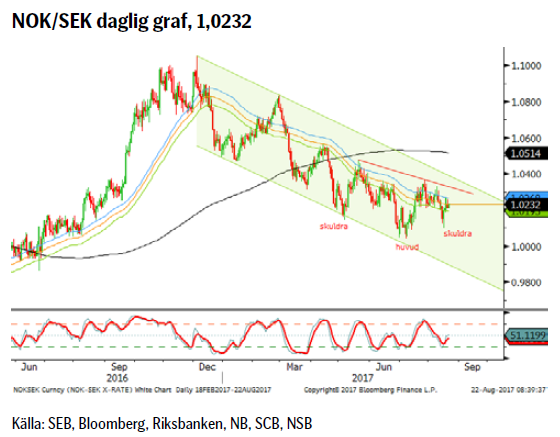 Denna vecka bjuder på en hel del ekonomisk statistik från Sverige men framför allt från Norge. Idag kom konsumentförtroendet för kv. 3 från Norge som blev 16.2 jämfört med 11.1 förra kvartalet. På onsdag kommer norsk arbetslöshet och på torsdag norsk BNP för andra kvartalet samt resultatet för den senaste oljeinvesteringsenkäten. Statistiskt uppvisar norsk BNP och EUR/NOK den högsta korrelationen för ekonomisk statistik och NOK-rörelser. För svensk del har vi arbetslöshetsstatistik på torsdag och PPI samt hushållsutlåningen på fredag. En eventuell NOK/SEK rörelse bör i all huvudsak vara föremål för utfallet av norsk statistik som i all huvudsak är viktigare än svensk denna vecka. Den tekniska analysen pekar på ett ökande efterfrågetryck i NOK/SEK.
Denna vecka bjuder på en hel del ekonomisk statistik från Sverige men framför allt från Norge. Idag kom konsumentförtroendet för kv. 3 från Norge som blev 16.2 jämfört med 11.1 förra kvartalet. På onsdag kommer norsk arbetslöshet och på torsdag norsk BNP för andra kvartalet samt resultatet för den senaste oljeinvesteringsenkäten. Statistiskt uppvisar norsk BNP och EUR/NOK den högsta korrelationen för ekonomisk statistik och NOK-rörelser. För svensk del har vi arbetslöshetsstatistik på torsdag och PPI samt hushållsutlåningen på fredag. En eventuell NOK/SEK rörelse bör i all huvudsak vara föremål för utfallet av norsk statistik som i all huvudsak är viktigare än svensk denna vecka. Den tekniska analysen pekar på ett ökande efterfrågetryck i NOK/SEK.
Konklusion: Bättre än förväntad norsk BNP statistik på torsdag kan få NOK/SEK att ta fart uppåt.
OBSERVATIONER
+ Oljepriset har repat sig från de lägsta nivåerna under sommaren.
+ Norges Bank har en positiv styrränta (0,5 %).
+ Norsk ekonomi återhämtar sig från oljeprisfallet.
+ Riksbanken är fortsatt mycket expansiv.
+ Vår modell för positionering visar på att spekulanterna är korta NOK vilket riskerar att utlösa stoppar vid en NOK förstärkning.
+ NOK/SEK ser ut att eventuellt kunna göra eventuell inverterad huvud/skuldra bottenformation.
+ EUR/NOK ser ut att forma en björnflagga.
– Vår modell för positionering visar att spekulanterna är korta och förväntar sig en svagare NOK.
– Sve ekonomi är stark (ek.överraskningsindex högsta på 11 år)
– Om Riksbanken snabbare än förväntat blir mer hökaktig vilket vi är lite skeptiska till givet den senaste SEK-förstärkningen.
– Lägenhetspriserna i Oslo har under de senaste månaderna fallit
– Tekniskt sett befinner vi oss fortfarande i en fallande kanal men de senaste bottnarna kommer allt längre från botten av denna vilket är ett svaghetstecken i trenden.
Tillgängliga certifikat:
BULL NOKSEK X4 S
BEAR NOKSEK X4 S
OMX (TEKNISK ANALYS)
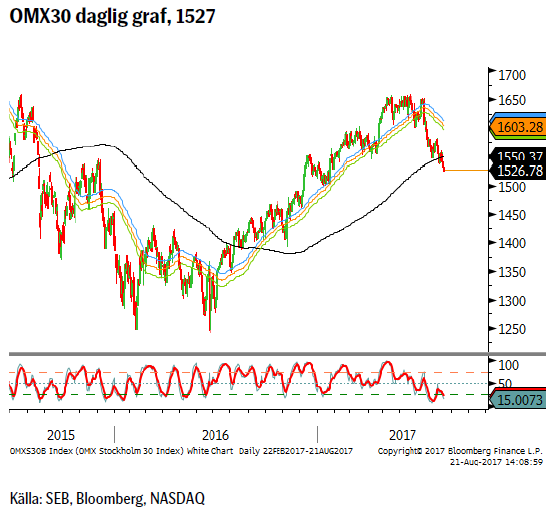 Utvecklingen under sommaren, sedan vår varning om att marknaden verkade misslyckas att ta sig tillbaka över 55dagars medelvärdesbandet (efter att juni utvecklats till en vändningsmånad), är helt klart oroväckande. I och med brottet under både 55dagars bandet och under 233d glidande mv så är den korta trenden bekräftad negativ. I skrivande stund testar vi nu 55veckors medelvärdesbandets nedre del och skulle även detta stöd ge vika öppnar vi upp för 233v mv som just nu ligger vid 1428. Dock finns det indicier i dagsgrafen om att vi nu börjar närma oss åtminstone en kortare positiv rekyl (men frågan är om vi inte får se nya bottnar därefter).
Utvecklingen under sommaren, sedan vår varning om att marknaden verkade misslyckas att ta sig tillbaka över 55dagars medelvärdesbandet (efter att juni utvecklats till en vändningsmånad), är helt klart oroväckande. I och med brottet under både 55dagars bandet och under 233d glidande mv så är den korta trenden bekräftad negativ. I skrivande stund testar vi nu 55veckors medelvärdesbandets nedre del och skulle även detta stöd ge vika öppnar vi upp för 233v mv som just nu ligger vid 1428. Dock finns det indicier i dagsgrafen om att vi nu börjar närma oss åtminstone en kortare positiv rekyl (men frågan är om vi inte får se nya bottnar därefter).
Konklusion: En mindre positiv korrektion ser trolig ut i närtid. På lite längre sikt är risken fortfarande på nedsidan.
OBSERVATIONER
+ Ekonomisk statistik fortsätter att vara positiv.
+ Det långsiktiga vågmönstret är positivt.
+ Kortsiktigt så är marknaden översåld och har en tendens till en positiv divergens mellan pris och indikator.
– Stigande räntor (mer uppgång efter innevarande konsolidering/korrektion).
– Månadsvändningssignal per sista juni.
– 55d mv band brutet och priset kvarstår i/under detta.
– 233d mv brutet.
– En ”överdrivet” lång uppgångssekvens (11 månader i sträck) bröts i och med nedgången in juni.
– Vecko och månadsgraferna är överköpta. På veckobasis har vi inte varit så här överköpta sedan inför toppen 2015.
– Fem vågor ned från toppen är illavarslande.
Tillgängliga certifikat:
BULL OMX X5, X10 & X15 S
BEAR OMX X1, X5, X10 & X15 S
UTVECKLING SENASTE VECKAN SAMT SEDAN ÅRETS BÖRJAN
[box]SEB Veckobrev Veckans råvarukommentar är producerat av SEB:s Commodities Sales desk och publiceras i samarbete och med tillstånd på Råvarumarknaden.se[/box]
KÄLLOR
Bloomberg, Reuters, SEB
VILLKOR
För varje enskilt certifikat/mini future finns Slutliga Villkor som anger de fullständiga villkoren. Slutliga Villkor finns tillgängligt på kurssidan för respektive certifikat/mini future på www.seb.se, Börs & finans, fliken Strukturerade placeringar.
RISKER
En sammanfattning av de risker som är förknippade med Börshandlade certifikat generellt finns i Produktbroschyren för respektive certifikat eller mini future som är tillgängligt på seb.se/cert respektive seb.se/mini. För en fullständig bild av riskerna behöver du ta del av SEB:s offentliggjorda Grundprospekt för Certifikat- och Warrantprogram som är publicerat på www.seb.se/cert respektive seb.se/mini.
DISCLAIMER
Detta marknadsföringsmaterial, framtaget av SEB:s Commodities Sales desk, har upprättats enbart i informationssyfte.
Även om innehållet är baserat på källor som SEB bedömt som tillförlitliga ansvarar SEB inte för fel eller brister i informationen. Den utgör inte oberoende, objektiv investeringsanalys och skyddas därför inte av de bestämmelser som SEB har infört för att förebygga potentiella intressekonflikter. Yttranden från SEB:s Commodities Sales desk kan vara oförenliga med tidigare publicerat material från SEB, då den senare hänvisas uppmanas du att läsa den fullständiga rapporten innan någon åtgärd vidtas.
Dokumentationen utgör inte någon investeringsrådgivning och tillhandahålls till dig utan hänsyn till dina investeringsmål. Du uppmanas att självständigt bedöma och komplettera uppgifterna i denna dokumentation och att basera dina investeringsbeslut på material som bedöms erforderligt. Alla framåtblickande uttalanden, åsikter och förväntningar är föremål för risker, osäkerheter och andra faktorer och kan orsaka att det faktiska resultatet avviker väsentligt från det förväntade. Historisk avkastning är ingen garanti för framtida resultat. Detta dokument utgör inte ett erbjudande att teckna några värdepapper eller andra finansiella instrument. SEB svarar inte för förlust eller skada – direkt eller indirekt, eller av vad slag det vara må – som kan uppkomma till följd av användandet av detta material eller dess innehåll.
Observera att det kan förekomma att SEB, dess ledamöter, dess anställda eller dess moder- och/eller dotterbolag vid olika tillfällen innehar, har innehaft eller kommer att inneha aktier, positioner, rådgivningsuppdrag i samband med corporate finance-transaktioner, investment- eller merchantbanking-uppdrag och/eller lån i de bolag/finansiella instrument som nämns i materialet.
Materialet är avsett för mottagaren, all spridning, distribuering mångfaldigande eller annan användning av detta meddelande får inte ske utan SEB:s medgivande. Materialet riktar sig inte till personer vars medverkan kräver ytterligare prospekt, registrerings- eller andra åtgärder än vad som följer av svensk rätt. Det åligger var och en att iaktta sådana restriktioner. Materialet får inte distribueras i eller till land där distribution kräver ovan nämnda åtgärder eller strider mot reglering i sådant land. Materialet riktar sig således inte till fysiska eller juridiska personer hemmahörande i USA eller i något annat land där publicering eller tillhandahållande av materialet är förbjudet eller strider mot tillämpliga bestämmelser i landet.
Oaktat detta får SEB tillåta omfördelning av materialet till utvald tredje part i enlighet med gällande avtal. Materialet får inte spridas till fysiska eller juridiska personer som är medborgare eller har hemvist i ett land där sådan spridning är otillåten enligt tillämplig lag eller annan bestämmelse.
Skandinaviska Enskilda Banken AB (publ) är ett publikt aktiebolag och står under tillsyn av Finansinspektionen samt de lokala finansiella tillsynsmyndigheter i varje jurisdiktionen där SEB har filial eller dotterbolag.
Analys
Tightening fundamentals – bullish inventories from DOE

The latest weekly report from the US DOE showed a substantial drawdown across key petroleum categories, adding more upside potential to the fundamental picture.

Commercial crude inventories (excl. SPR) fell by 5.8 million barrels, bringing total inventories down to 415.1 million barrels. Now sitting 11% below the five-year seasonal norm and placed in the lowest 2015-2022 range (see picture below).
Product inventories also tightened further last week. Gasoline inventories declined by 2.1 million barrels, with reductions seen in both finished gasoline and blending components. Current gasoline levels are about 3% below the five-year average for this time of year.
Among products, the most notable move came in diesel, where inventories dropped by almost 4.1 million barrels, deepening the deficit to around 20% below seasonal norms – continuing to underscore the persistent supply tightness in diesel markets.
The only area of inventory growth was in propane/propylene, which posted a significant 5.1-million-barrel build and now stands 9% above the five-year average.
Total commercial petroleum inventories (crude plus refined products) declined by 4.2 million barrels on the week, reinforcing the overall tightening of US crude and products.


Analys
Bombs to ”ceasefire” in hours – Brent below $70

A classic case of “buy the rumor, sell the news” played out in oil markets, as Brent crude has dropped sharply – down nearly USD 10 per barrel since yesterday evening – following Iran’s retaliatory strike on a U.S. air base in Qatar. The immediate reaction was: “That was it?” The strike followed a carefully calibrated, non-escalatory playbook, avoiding direct threats to energy infrastructure or disruption of shipping through the Strait of Hormuz – thus calming worst-case fears.

After Monday morning’s sharp spike to USD 81.4 per barrel, triggered by the U.S. bombing of Iranian nuclear facilities, oil prices drifted sideways in anticipation of a potential Iranian response. That response came with advance warning and caused limited physical damage. Early this morning, both the U.S. President and Iranian state media announced a ceasefire, effectively placing a lid on the immediate conflict risk – at least for now.
As a result, Brent crude has now fallen by a total of USD 12 from Monday’s peak, currently trading around USD 69 per barrel.
Looking beyond geopolitics, the market will now shift its focus to the upcoming OPEC+ meeting in early July. Saudi Arabia’s decision to increase output earlier this year – despite falling prices – has drawn renewed attention considering recent developments. Some suggest this was a response to U.S. pressure to offset potential Iranian supply losses.
However, consensus is that the move was driven more by internal OPEC+ dynamics. After years of curbing production to support prices, Riyadh had grown frustrated with quota-busting by several members (notably Kazakhstan). With Saudi Arabia cutting up to 2 million barrels per day – roughly 2% of global supply – returns were diminishing, and the risk of losing market share was rising. The production increase is widely seen as an effort to reassert leadership and restore discipline within the group.
That said, the FT recently stated that, the Saudis remain wary of past missteps. In 2018, Riyadh ramped up output at Trump’s request ahead of Iran sanctions, only to see prices collapse when the U.S. granted broad waivers – triggering oversupply. Officials have reportedly made it clear they don’t intend to repeat that mistake.
The recent visit by President Trump to Saudi Arabia, which included agreements on AI, defense, and nuclear cooperation, suggests a broader strategic alignment. This has fueled speculation about a quiet “pump-for-politics” deal behind recent production moves.
Looking ahead, oil prices have now retraced the entire rally sparked by the June 13 Israel–Iran escalation. This retreat provides more political and policy space for both the U.S. and Saudi Arabia. Specifically, it makes it easier for Riyadh to scale back its three recent production hikes of 411,000 barrels each, potentially returning to more moderate increases of 137,000 barrels for August and September.
In short: with no major loss of Iranian supply to the market, OPEC+ – led by Saudi Arabia – no longer needs to compensate for a disruption that hasn’t materialized, especially not to please the U.S. at the cost of its own market strategy. As the Saudis themselves have signaled, they are unlikely to repeat previous mistakes.
Conclusion: With Brent now in the high USD 60s, buying oil looks fundamentally justified. The geopolitical premium has deflated, but tensions between Israel and Iran remain unresolved – and the risk of missteps and renewed escalation still lingers. In fact, even this morning, reports have emerged of renewed missile fire despite the declared “truce.” The path forward may be calmer – but it is far from stable.
Analys
A muted price reaction. Market looks relaxed, but it is still on edge waiting for what Iran will do

Brent crossed the 80-line this morning but quickly fell back assigning limited probability for Iran choosing to close the Strait of Hormuz. Brent traded in a range of USD 70.56 – 79.04/b last week as the market fluctuated between ”Iran wants a deal” and ”US is about to attack Iran”. At the end of the week though, Donald Trump managed to convince markets (and probably also Iran) that he would make a decision within two weeks. I.e. no imminent attack. Previously when when he has talked about ”making a decision within two weeks” he has often ended up doing nothing in the end. The oil market relaxed as a result and the week ended at USD 77.01/b which is just USD 6/b above the year to date average of USD 71/b.

Brent jumped to USD 81.4/b this morning, the highest since mid-January, but then quickly fell back to a current price of USD 78.2/b which is only up 1.5% versus the close on Friday. As such the market is pricing a fairly low probability that Iran will actually close the Strait of Hormuz. Probably because it will hurt Iranian oil exports as well as the global oil market.
It was however all smoke and mirrors. Deception. The US attacked Iran on Saturday. The attack involved 125 warplanes, submarines and surface warships and 14 bunker buster bombs were dropped on Iranian nuclear sites including Fordow, Natanz and Isfahan. In response the Iranian Parliament voted in support of closing the Strait of Hormuz where some 17 mb of crude and products is transported to the global market every day plus significant volumes of LNG. This is however merely an advise to the Supreme leader Ayatollah Ali Khamenei and the Supreme National Security Council which sits with the final and actual decision.
No supply of oil is lost yet. It is about the risk of Iran closing the Strait of Hormuz or not. So far not a single drop of oil supply has been lost to the global market. The price at the moment is all about the assessed risk of loss of supply. Will Iran choose to choke of the Strait of Hormuz or not? That is the big question. It would be painful for US consumers, for Donald Trump’s voter base, for the global economy but also for Iran and its population which relies on oil exports and income from selling oil out of that Strait as well. As such it is not a no-brainer choice for Iran to close the Strait for oil exports. And looking at the il price this morning it is clear that the oil market doesn’t assign a very high probability of it happening. It is however probably well within the capability of Iran to close the Strait off with rockets, mines, air-drones and possibly sea-drones. Just look at how Ukraine has been able to control and damage the Russian Black Sea fleet.
What to do about the highly enriched uranium which has gone missing? While the US and Israel can celebrate their destruction of Iranian nuclear facilities they are also scratching their heads over what to do with the lost Iranian nuclear material. Iran had 408 kg of highly enriched uranium (IAEA). Almost weapons grade. Enough for some 10 nuclear warheads. It seems to have been transported out of Fordow before the attack this weekend.
The market is still on edge. USD 80-something/b seems sensible while we wait. The oil market reaction to this weekend’s events is very muted so far. The market is still on edge awaiting what Iran will do. Because Iran will do something. But what and when? An oil price of 80-something seems like a sensible level until something do happen.
-

 Nyheter4 veckor sedan
Nyheter4 veckor sedanStor uppsida i Lappland Guldprospekterings aktie enligt analys
-

 Nyheter4 veckor sedan
Nyheter4 veckor sedanSilverpriset släpar efter guldets utveckling, har mer uppsida
-

 Nyheter3 veckor sedan
Nyheter3 veckor sedanUppgången i oljepriset planade ut under helgen
-

 Nyheter2 veckor sedan
Nyheter2 veckor sedanMahvie Minerals växlar spår – satsar fullt ut på guld
-

 Nyheter3 veckor sedan
Nyheter3 veckor sedanLåga elpriser i sommar – men mellersta Sverige får en ökning
-

 Analys3 veckor sedan
Analys3 veckor sedanVery relaxed at USD 75/b. Risk barometer will likely fluctuate to higher levels with Brent into the 80ies or higher coming 2-3 weeks
-

 Nyheter2 veckor sedan
Nyheter2 veckor sedanOljan, guldet och marknadens oroande tystnad
-

 Nyheter2 veckor sedan
Nyheter2 veckor sedanJonas Lindvall är tillbaka med ett nytt oljebolag, Perthro, som ska börsnoteras



